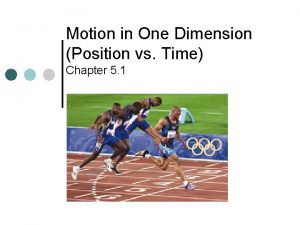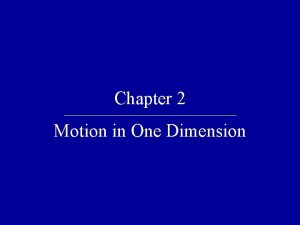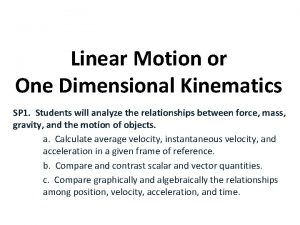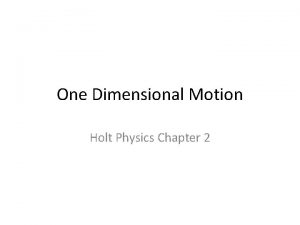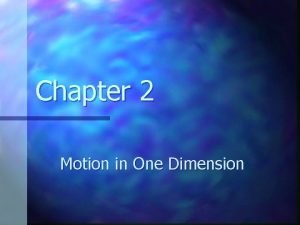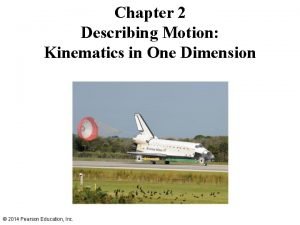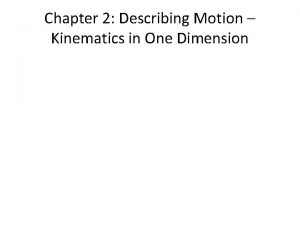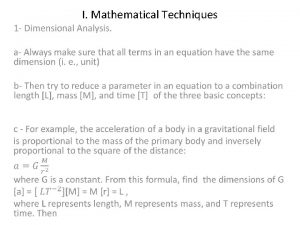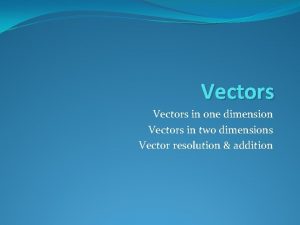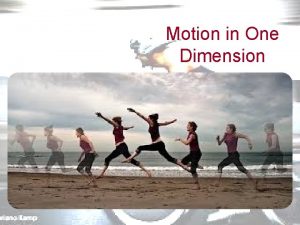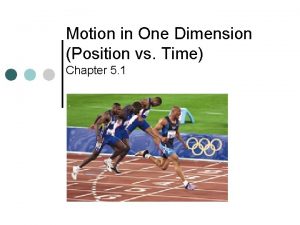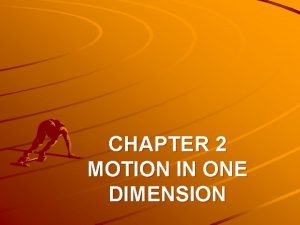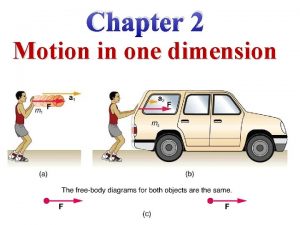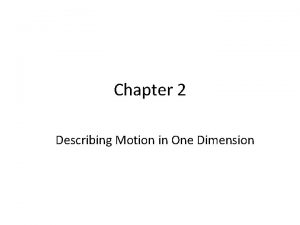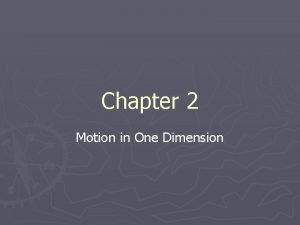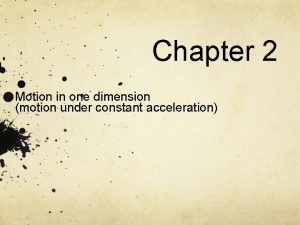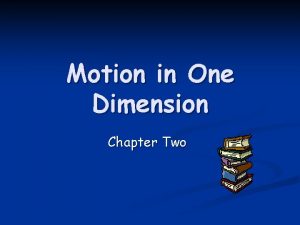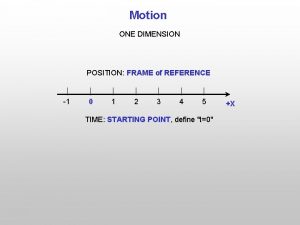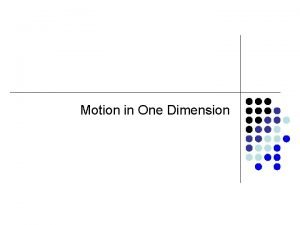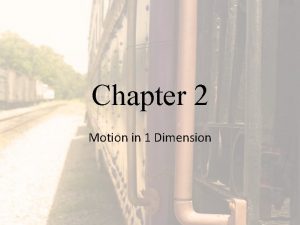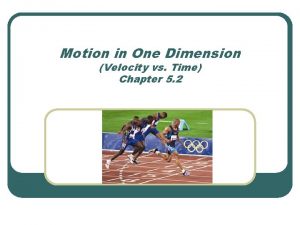Motion in One Dimension Position vs Time Chapter



















- Slides: 19

Motion in One Dimension (Position vs. Time) Chapter 5. 1

Distance, Position and Displacement ¢ Distance: The total distance that an object has moved irrespective of your starting position. Ex. You walk 3 meters north and then walk 3 meters south. What distance have you traveled? l 6 meters l

Distance, Position and Displacement ¢ Position: Where you are relative to a starting or reference point. Ex. : You walk 3 meters north. l Your position is 3 meters from your starting or reference point. l

Distance, Position and Displacement ¢ Displacement: A measure in distance relative to a starting point that includes direction. l Ex. : You walk 3 meters north and then 3 meters south. What is your displacement? • 0 meters. l Ex. : Your walk 6 meters north and 8 meters east. What is your distance traveled? What is your displacement? • Distance: 14 meters. • Displacement: 10 meters NE.

Motion of Objects ¢ To describe the motion of an object, what other information will we need other than position, distance or displacement? l ¢ If I have the object’s position and time, what can be determined about the object’s motion? l ¢ Time Speed or Velocity, or Acceleration. Now, lets collect some data

1. Collect Data

2. Choose appropriate axes and plot the data.

3. Draw a curve that provides a “best fit” to the points.

What information does the shape of the curve provide? Straight line = constant velocity. ¢ Changing curve = changing velocity(i. e. acceleration). Position ¢ Time Constant Velocity Time Changing Velocity

What information does the shape of the curve provide? Negative Acceleration Position Decreasing Velocity Position Positive Acceleration Time Position Increasing Velocity Time

Characterize the motion of the object from A to E. E Position A. Constant velocity in the positive direction. B. Decreasing velocity. C. Stationary. D. Increasing velocity. E. Constant velocity in the positive direction. B C A Time D

What information does the slope of the curve provide? Positively sloped curve = movement in the positive direction. n Negatively sloped curve = movement in the negative direction. Position n Time Positive Direction Negative Direction

What else does the slope tell us? n What is the motion described by each curve? How does the velocity of each curve compare to one another? • • • A is stationary B is moving at the same speed as C, but their starting position is different. D is moving slower than B or C. C Position n B A D Time

What is the significance of the slope of the position vs. time curve? n Since position is on the y-axis and time is on the x-axis, it follows that the slope of the line would be: n Therefore, slope must equal speed or velocity. Time

Determining the slope of the curve. 1997 World Championships - Athens, Greece Maurice Green 100 90 80 y = 11. 65 x - 13. 07 2 R = 1. 00 Distance (m) 70 60 50 40 30 20 2 y = 1. 13 x + 4. 08 x - 0. 05 2 R = 1. 00 10 0 0 2 4 6 Time (s) 8 10

Velocity determined from the slope of the curve. rise Slope = run df – d i m= t f – ti 85 m-50 m 8. 4 s-5. 4 s m = 11. 7 m/s Since m = v: v = 11. 7 m/s 100 90 80 Distance (m) m= 1997 World Championships - Athens, Greece Maurice Green 70 y = 11. 65 x - 13. 07 2 R = 1. 00 60 50 40 30 4 5 6 7 Time (s) 8 9 10

Key Ideas ¢ ¢ Although space exists in 3 dimensions, analysis of objects in motion can be limited to one dimension to simplify problems. When graphing position vs. time, use the x-axis for time and the y-axis for position. By analyzing the shape of a position vs. time graph, the relative motion of the object can be determined, i. e. constant velocity, acceleration, stationary. The slope of the position vs. time graph provides the average velocity over the time interval.

Analyzing motion of more than one object. ¢ Two vehicles travel through a speed trap traveling at two different velocities.

What can be inferred from the following graph?
 Chapter 2 motion in one dimension answer key
Chapter 2 motion in one dimension answer key To describe a position in more than one dimension
To describe a position in more than one dimension Motion in one dimension quiz
Motion in one dimension quiz Kinematics in one dimension
Kinematics in one dimension Holt physics chapter 2
Holt physics chapter 2 Free fall motion in one dimension
Free fall motion in one dimension Motion in one dimension
Motion in one dimension Describing motion kinematics in one dimension
Describing motion kinematics in one dimension Describing motion kinematics in one dimension
Describing motion kinematics in one dimension 2d motion equations
2d motion equations Motion in one dimension
Motion in one dimension 5th position
5th position Forces in one dimension vocabulary review
Forces in one dimension vocabulary review Chapter 4: forces in one dimension answer key
Chapter 4: forces in one dimension answer key Describing motion chapter 1 lesson 1
Describing motion chapter 1 lesson 1 Simple harmonic motion notes
Simple harmonic motion notes Chapter 2 section 1 describing motion answer key
Chapter 2 section 1 describing motion answer key Describing and measuring motion
Describing and measuring motion Section 1 describing motion
Section 1 describing motion Vectors
Vectors

